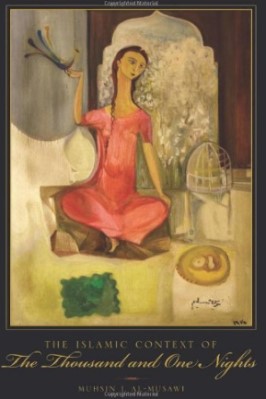
| The Islamic Context Of The Thousand And One Nights |
| Muhsin al-Musawi |
| 352 |
| |
| PDF Direct Download Link |
| Click for Hard Copy from Amazon |
THE ISLAMIC CONTEXT OF THE THOUSAND AND ONE NIGHTS – Book Sample
About the Book – THE ISLAMIC CONTEXT OF THE THOUSAND AND ONE NIGHTS
In this fascinating study, Muhsin J. al-Musawi shows how deeply Islamic heritage and culture is embedded in the tales of The Thousand and One Nights (known to many as the Arabian Nights) and how this integration invites readers to make an Islamic milieu.
Conservative Islam dismisses The Thousand and One Nights as facile popular literature, and liberal views disregard the rich Islamic context of the text. Approaching the text with a fresh and unbiased eye, al-Musawi reads the tales against Islamic schools of thought and theology and recovers persuasive historical evidence to reveal the cultural and religious struggle over Islam that drives the book’s narrative tension and binds its seemingly fragmented stories.
Written by a number of authors over a stretch of centuries, The Thousand and One Nights depicts a burgeoning, urban Islamic culture in all its variety and complexity.
As al-Musawi demonstrates, the tales document their own places and periods of production, reflecting the Islamic individual’s growing exposure to a number of entertainments and temptations and their conflict with the obligations of faith.
Aimed at a diverse audience, these stories follow a narrative arc that begins with corruption and ends with redemption, conforming to a paradigm that concurs with the sociological and religious concerns of Islam and the Islamic state.
By emphasizing Islam in his analysis of these entertaining and instructional tales, al-Musawi not only illuminates the work’s consistent equation between art and life, but he also sheds light on its underlying narrative power. His study offers a brilliant portrait of medieval Islam as well, especially its social, political, and economic institutions and its unique practices of storytelling.
CONTENTS
- Acknowledgments
- Introduction: Is There an Islamic Context for The Thousand and One Nights?
- THE ISLAMIC FACTOR IN GLOBAL TIMES
- The Islamic and the Foreign Perspectives
- The Early Vogue as a Global Index The Frame Tale as Navigational Trope
- Framing a Collection or Framing Cultures?
- Warnings Grounded in Islamic Law Multiple Approaches to the Frame Tale The Moral Implication in the Frame Story Resignation or Submission to Fate?
- Narrating Cultural Consciousness The Frame Story in Historical Contexts
- The Frame Story as Urban Growth
- THE UNIFYING ISLAMIC FACTOR
- Narrative Challenge and Attraction Upholding Human Propensity to Security
- The Ordering of Good and the Forbidding of Evil From Transmission to Narration
- The Natural and the Supernatural Companionship The Supernatural as Moral Authority
- The Islamic Narrative Function Loose Thematic Patterns
- The Particular and the Universal in Religion In Celebration of God
- Binding Commitments and Pledges
- Islamic or Not? The Nature of the Discriminatory Instance The Islamic Law and the State
- Law and Terms of Beauty The Paradisiacal Referent The Sanctified Sphere
- Apostasy and the End of Narrative Love or Sex?
- Vicissitudes of Fortune and Human Frailties
- THE AGE OF MUSLIM EMPIRE AND THE BURGEONING OF A TEXT
- Representational or Parodic Education and the Paradigm of Rise and Fall
- Knowledge and the Growth of Empire Education and Vicissitudes of Fate Grounding in Magic
- Education: Artists and Cultivated Taste Refinement, Profession, and Class Marketability and Freedom as Topography Urbanity and Love
- Tropes for Imperial Growth: Race and Acquisition of Slaves Islamic Law and the Needs of the Empire
- Expediency, and the Center That Does Not Hold
- Narrative as Historiography
- Vagaries of Politics
- Wealth and Luxury as Signs of Deterioration
- THE CHANGING ORDER: THE ROLE OF THE PUBLIC IN THE THOUSAND AND ONE NIGHTS
- The Imperial and the Islamic Sites of Popular Faith: Book Markets
- Competing Centers or Competing Dynasties?
- Metropolitan Temptations Travels to the Metropolis Professions and Crafts
- Narrating the Journey of Consciousness From Regression to Progression The Liberating In-betweenness
- Wine and Islamic Prohibitions Social Interdependency Idolatry and Monotheism
- The Urban and the Imperial
- Cairene Narratives and the Displacement of the Sacred Ethics and Morals
- Narrating Desire as Sexual Intrigues Institutionalized Religion and Issues of Sects Christians and Jews in an Islamic Environment Heathen and Islamic Narrative
- NONRELIGIOUS DISPLACEMENTS IN POPULAR TRADITION
- The Unwritten Tale As Medieval Narrative
- Dichotomous Patterning in the Classical Tradition Signs and Sites of Transgression
- Appropriation for the Urban Classes Urban Narrative Sites
- THE PUBLIC ROLE IN ISLAMIC NARRATIVE THEORIZATIONS
- SCHEHERAZADE’S NONVERBAL NARRATIVES IN RELIGIOUS CONTEXTS
- What Is Nonverbal Narrative? Scriptoria and the Blank Page Iconic Inscription or Calligraphy
- Talismans, Magical Practices, and Amulets The Nonverbal in Human Action
- Women’s Counterhegemonic Discourse Mental Images and Pictorial Resolutions Food Semiotics
- The Zero Meal
- CONCLUSION
- Notes
- Bibliography
- Index
To read more about the The Islamic Context Of The Thousand And One Nights book Click the download button below to get it for free
Report broken link
Support this Website
for websites